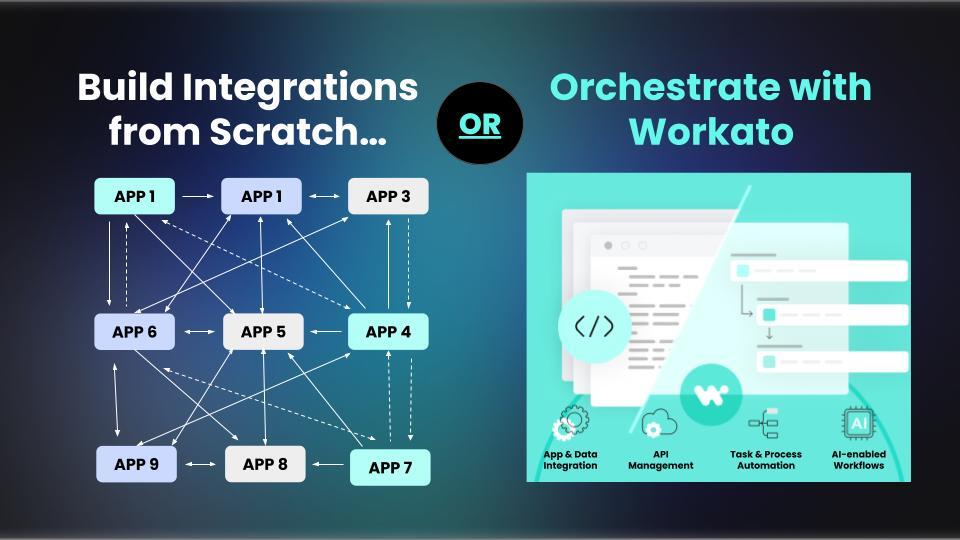367 – That’s the number of business applications in the typical company’s technology ecosystem, according to Forrester.
Despite each app’s promise to enhance its stakeholder’s work, they are typically disconnected from the rest of your tech stack, creating data silos, duplicative manual tasks, and grounds for human error. Given the laser focus on employee efficiency, requests for integration and automation pile up in the IT organization’s queue to remedy the situation. Custom coding native app integrations is just the tip of the iceberg; upgrades, maintenance, and addressing new business needs are moving targets.
At some point, you are faced with a decision when it comes to integrating and automating processes across your company: should you build a custom solution in-house or buy a pre-existing one?
Challenges with Building In-House Solutions
While the allure of a tailored system designed to meet the specific needs of a business is tempting, the pitfalls of building such a solution from scratch turn your backlog into a game of Whack-a-Mole, with new issues popping up as fast as you can tackle them. One of the primary challenges of building an integration and automation solution in-house is the sheer complexity and resource commitment required. Custom-built solutions often rely on the expertise of a few specialized developers, whose time is valuable, and things fall apart when they move teams or, worse, take a job at a different company. There is little time for documentation, regression testing, and bug fixes–let alone new features. The expensive work gets wasted in the long run.
Investing in a proven platform for integration and automation can minimize the work required for implementation, maintenance, and governance, making it easy to scale development and drive velocity. This allows developers to focus on more strategic tasks rather than getting bogged down with the intricacies of integration. A purchased solution often comes with the added benefits of cloud-native hosting, support, and updates from the vendor, which can be a significant advantage over a custom-built system that may quickly become outdated or unsupported.
Empowering IT Teams
As the nature of work relies on technology more and more, IT organizations are under pressure to drive speed to market. In today’s competitive environment, how fast you move as an IT organization can make or break how well a company operates. Building a solution in-house is time-consuming and slows the business’s ability to execute. A platform to orchestrate your integrations and automations lets you build, test, and deploy much more quickly and with fewer resources. Beyond the efficiency of leveraging an existing platform, particularly if it’s low-code / no-code, you are taking an extensible approach that yields higher performance.
Workato customer Ashik Ahmed said it well:

“The right way of doing things is using proper frameworks and no-code tools where APIs and other things are managed or abstracted… So you can achieve the business objectives without incurring technical debt.”
-Ashik Ahmed, CEO/CTO at Deputy
Check out Ashik’s video to hear more about why he chose to stop building internal systems from scratch and invest in Workato instead.
Achieving Scale and Speed
Workato gives you the versatility, speed, and empowerment to integrate everything, automate anything, and orchestrate across your entire organization. With a low-code / no-code platform, technical and functional teams can work together to get projects done faster and more effectively. It’s done on a foundation of secure, reliable, zeroOps integrations, which opens the door for deep process automation and AI-enabled workflows. To scale, you must be able to build solutions in hours and days rather than weeks and months. You need to invest time in the work that evolves your organization and drives results rather than maintaining break/fix issues.
While building integrations from scratch is tempting, at some point the limitations, maintenance, and short-term solutions for long-term problems have to be addressed. Investing in the right platform can provide immediate access to a robust, scalable, and supported system that frees up valuable IT resources and accelerates business growth. Organizations need to carefully consider these factors and choose the path that aligns best with their strategic goals and capabilities.

What’s Better: Build in-house or Buy Existing?
Explore the full comparison of building or buying a solution for integration and automation
